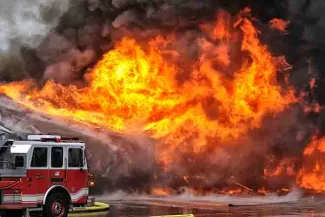
Wildfire AI technology offers key data - for a price
(Colorado Newsline) A Colorado legislative committee tasked with exploring wildfire prevention and mitigation advanced a bill that would bolster the development of artificial intelligence services to predict wildfires, though it would come with a hefty price tag.
The bill would send about $7.5 million to the state’s Division of Fire Prevention and Control to continue a partnership with Lockheed Martin that developed wildfire fighting AI applications. The division has been using the technology through a pilot program that is set to expire.
“They have Version 1 developed, and they’re exercising that pilot software now in parallel to all the other things that are happening with firefighting,” Senator Mark Baisley, a Sedalia Republican, said during the committee’s most recent meeting. “But they just don’t have the internal money — it’s gone and it’s been spent. The concern is the software developers would either be laid off or assigned to some other long-term project, and it would be difficult to get them back.”

The Legislature is not in session, but the committee met on an interim basis.
Lockheed Martin, which has its space division headquartered in Littleton, created four wildfire prediction services that rely on AI. Those services map fuel, predict lightning strikes that could ignite a fire, create fire perimeters using satellites, and predict how a wildfire is likely to spread. They can provide data to firefighters and public safety officers quicker than traditional modeling. It is part of a burgeoning industry to find AI applications for wildfire management.
“These services are utilizing AI to drive speed in providing intelligence and data products to DFPC,” chief engineer Tim Burdick of Lockheed told the committee in August. Lockheed Martin has been providing the services to Colorado at no cost for the past two years during its pilot program.
The technology was able to detect a “high ignition potential lightning event” about 3 kilometers from the start of the Oak Ridge Fire 42 hours before it started in southern Colorado this summer. It was also able to provide a spread prediction for the Alexander Martin Fire in Larimer County last month about 80 minutes after the fire was first reported, and then deliver daily spread predictions based on current conditions.
I share the sentiment that predictive technology could be a cost saver, ultimately, for the state, but a $7.5 million fiscal note is a real hurdle to consider in light of our current budgetary constraints.
– Representative Andrew Boesenecker
“That’s a perspective of how we’re utilizing these products, with the focus of leveraging artificial intelligence to take all that data, analyze, blend it and provide it outward to the agencies and decision makers,” Burdick said.
Lockheed Martin is hoping to finalize the technology and sell it to federal customers such as the U.S. Forest Service in 2025. But that leaves a funding gap, because it is a speculative product rather than the type of contract work the company usually takes on. The state’s investment would allow it to continue using the products for another year with the hope of it becoming operational at a federal level after that.

© iStock - Glenn_Hewitt
To Baisley, the $7.5 million cost would be justified if it could help the state avoid the billions of dollars in damage that out-of-control wildfires can create.
“It’s an investment that will show a return many, many times over,” he said.
But the fiscal impact could be a non-starter for lawmakers next year as they face one of the tightest budget scenarios in recent history.
“I share the sentiment that predictive technology could be a cost saver, ultimately, for the state, but a $7.5 million fiscal note is a real hurdle to consider in light of our current budgetary constraints,” Representative Andrew Boesenecker, a Fort Collins Democrat, said.
He said he wants to see an amendment that would position the state money as a backstop pending any grants, donations and federal funds for the project.
Bills advanced by interim committees need to be approved by the Legislative Council and are then introduced during the regular lawmaking term, which starts in January. They undergo the typical legislative process after introduction.
Colorado Newsline is part of States Newsroom, a nonprofit news network supported by grants and a coalition of donors as a 501c(3) public charity. Colorado Newsline maintains editorial independence. Contact Editor Quentin Young for questions: info@coloradonewsline.com. Follow Colorado Newsline on Facebook and X.

















